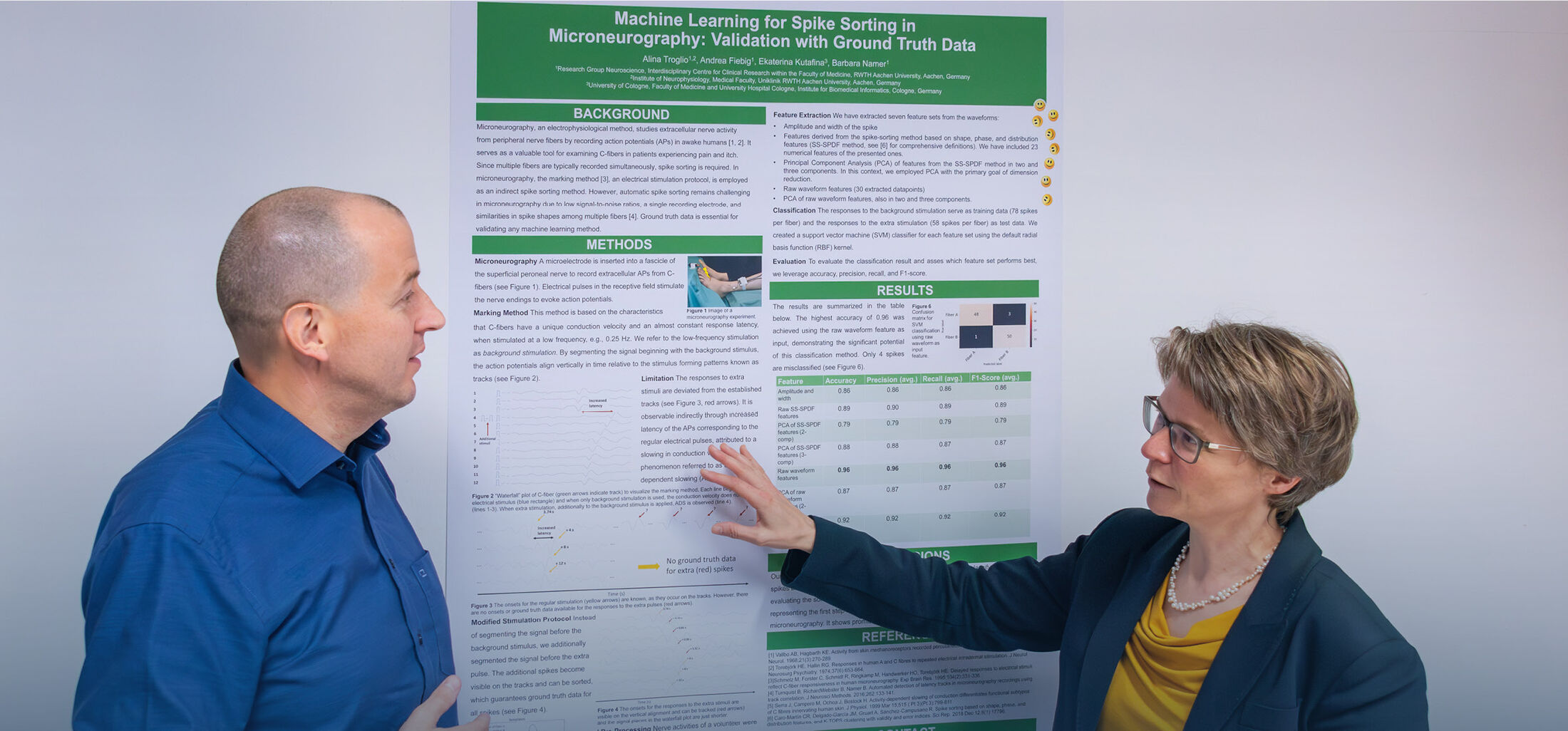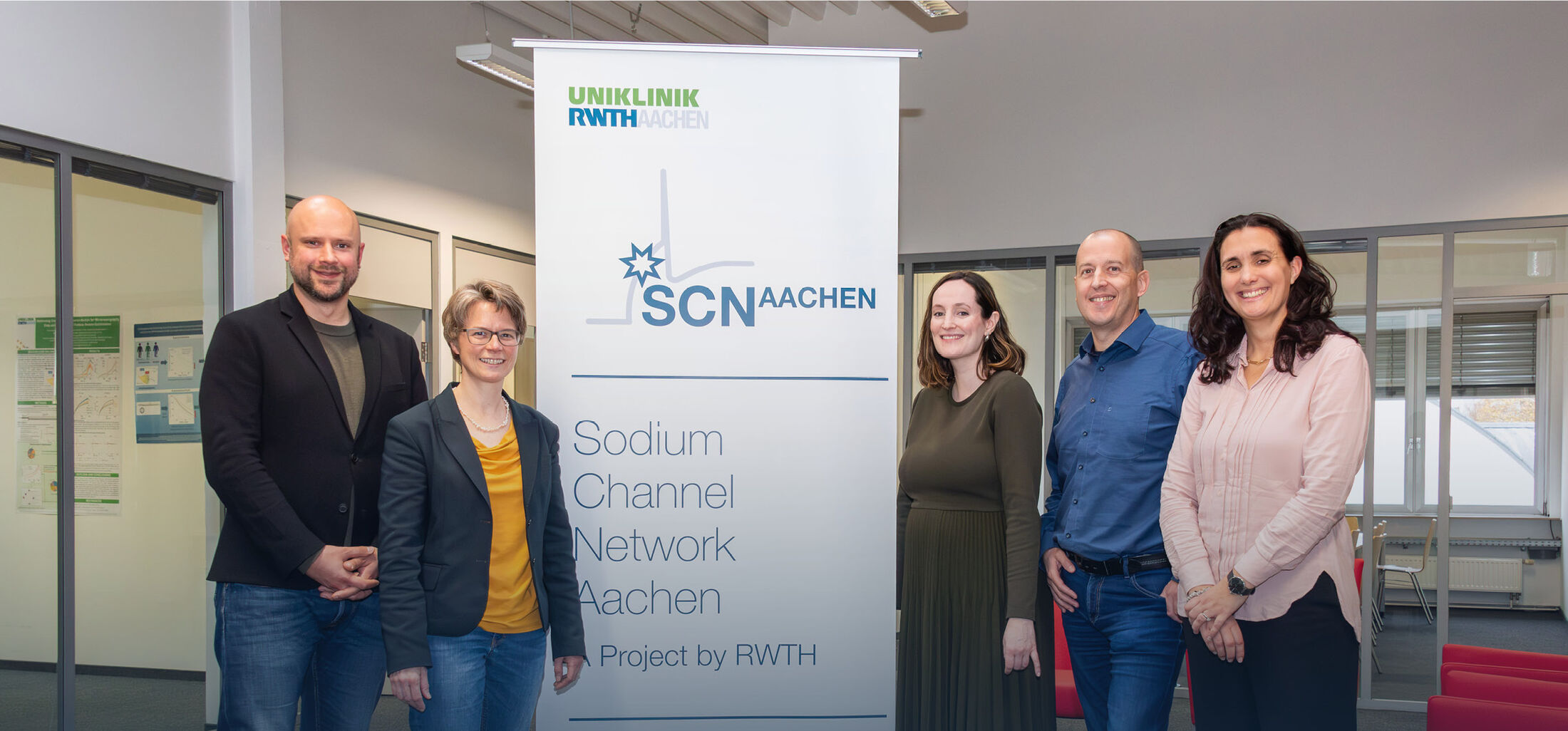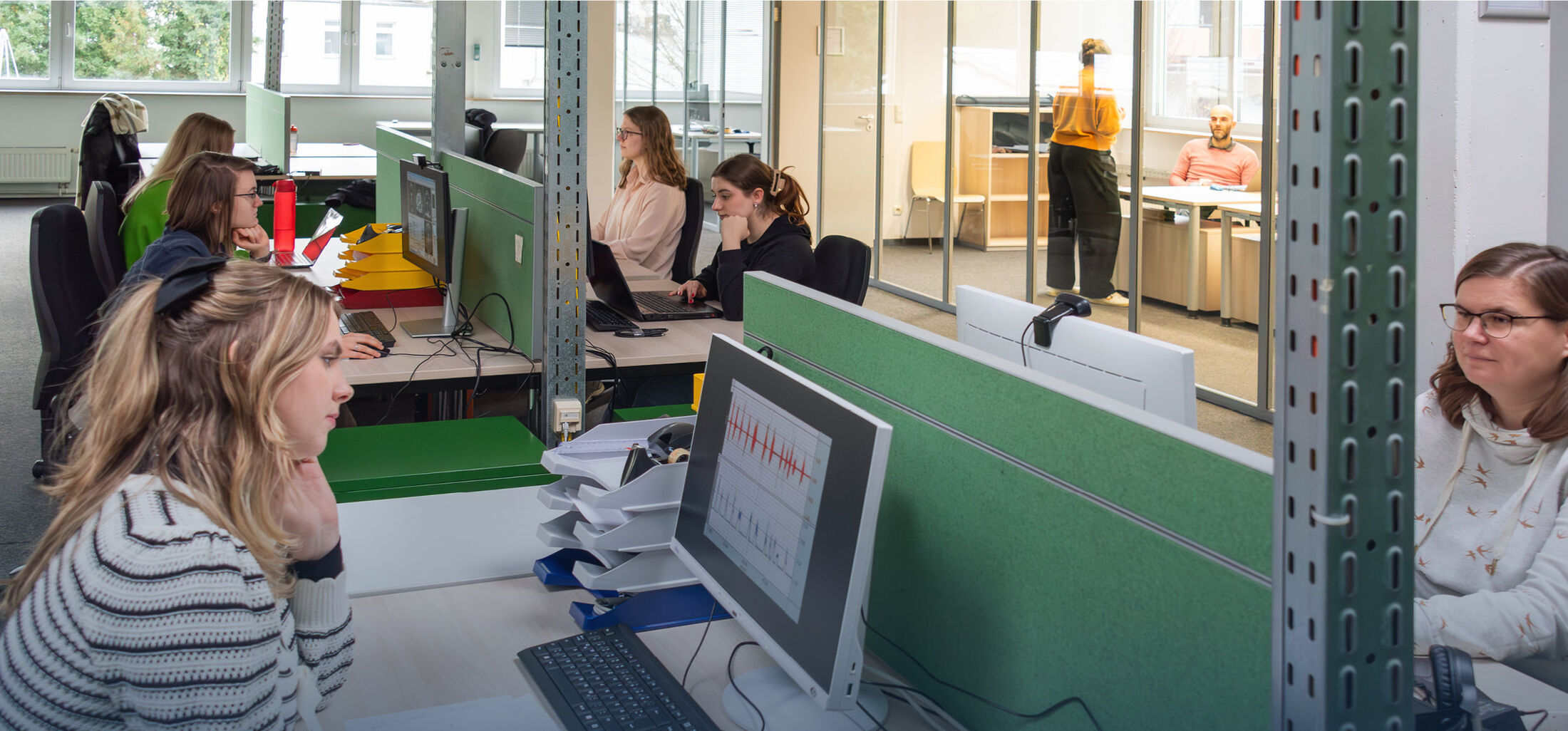Research
Welcome to the research page of the Scientific Center for Neuropathic Pain Aachen.
Here you can learn more about the research of the involved institutes, groups, and clinics. In the descriptions, you will find links to the respective websites.
Research performed within the Scientific Center for Neuropathic Pain Aachen SCN AACHEN
The Institute for Neurophysiology is dedicated to understanding the cellular and molecular mechanisms underlying chronic pain, particularly neuropathic pain. Our goal is to create a foundation for improved therapeutic approaches by gaining a more precise understanding of the disease mechanisms.
Human Cell Models
To translate our research findings into humans, we use induced pluripotent stem cells (iPS cells), which we derive from patient cells and differentiate into functional sensory and central neurons in the laboratory. These cells serve as a human model to investigate, for example, genetic changes, medications, or the effects of inflammation directly on human cells.
Voltage-Dependent Sodium Channels (Navs)
A particular focus of our research is the function of voltage-dependent sodium channels (Navs). These tiny protein structures are embedded in the membrane of neurons and regulate how nerve signals are transmitted in the body. They are crucial for the excitability of cells. Genetic changes or dysregulation of these channels can lead to chronic pain syndromes such as small-fiber neuropathy, as well as heart rhythm disorders or psychiatric illnesses.
Structure-Function Relationships
To understand how these changes affect the function of the channels, we investigate so-called structure-function relationships – that is, how specific regions of the channel control its activity. We use targeted mutagenesis to modify individual components of the channel and study their role.
Modern Methods
We analyze the channels in both patient-specific neurons derived from iPS cells in the laboratory and primary cells from pigs or humans. We employ modern methods:
- High-Throughput Patch-Clamp: measures the electrical activity of individual neurons
- Multi Electrode Arrays (MEAs): records the activity of entire cell groups
- PatchSeq: combines electrical measurements with simultaneous analysis of gene activity
- 3D Structure Modeling: provides insights into the molecular architecture of the channels
- Mutagenesis Studies: shows how targeted changes affect channel function
Goal
This combination of cell models, biophysics, and molecular analysis helps us identify mutation-specific drugs that could specifically counteract diseased channel changes. We aim to lay the foundation for personalized, but also population-based medicine.
According to estimates, up to 12 million people suffer from chronic pain in Germany alone. The chronification of pain is based on a complex and hitherto poorly understood interplay of biological and psychological mechanisms. As a result, pain loses its function as an acute sensory warning signal, while the emotional component of pain comes to the fore.
The 'Psychobiology of chronic pain' working group investigates the interactions between plastic changes in the (peripheral and central) nervous system and psychological processes (perception, experience, behavior) in order to better understand the development and maintenance of chronic pain. For this purpose, we combine psychometric, behavioural, and physiological methods, which we use in an experimental context in our pain laboratory and/or during functional magnetic resonance imaging. The aim is to derive innovative and mechanism-based therapeutic approaches. The focus of our research is currently on neuropathic pain syndromes (e.g., post-amputation pain, small fiber neuropathy) and pain processing in people with mental disorders. This research is supported, among other things, with funds from the HEAD-Genuit-Stiftung allocated to the Endowed Professorship in Psychobiology of Chronic Pain.
One key driver of neuropathic pain is altered excitability of peripheral nerves. At the Joint Research Center for Computational Biomedicine I, we aim to understand these pathological alterations by combining computational models of excitable membranes with technologies for probing the peripheral nerves. In our lab, we use Microneurography (unmyelinated fibers), Perception Threshold Tracking (thinly myelinated fiber), and Threshold tracking (large sensory and muscle fibers) to probe the fibers. For each experimental setup we have the corresponding conductance based multicompartmental model to understand our experimental results as well as to further developed our experimental setup. In the future we aim not only to understand pathological peripheral alterations but ultimately also for in silico drug screening to functionally restore the pathology.
At the Center of Human Genetics and Genomic Medicine, we explore the genetic foundations of pain perception and the causes of hereditary pain disorders. Using molecular genetic analyses and whole-genome sequencing, we search for genetic variations that may lead to reduced or increased pain sensitivity in affected individuals. New variants or previously unknown genes are further characterized through functional analyses in close collaboration with other research groups. This work aims to elucidate the molecular mechanisms of pain perception and pave the way for effective future treatments.
The research focus of the Biophysical Pharmacology of Ion Channels group (Prof. Hausmann) at the Institute of Clinical Pharmacology is the molecular function and biophysics of voltage- and ligand-gated ion channels. We are interested in understanding the dynamic molecular mechanisms responsible for the activation, gating behavior, ion permeation, conductance, and selectivity of these ion channels. Additionally, we conduct drug screening on ion channels to identify molecular determinants of subtype-specific drug interactions and to understand how P2X receptors (a class of ligand-gated ion channels) and NaV channels (a class of voltage-gated ion channels) can be selectively targeted by drugs. In the future, for example, pain-related mutations (variants) in voltage-gated sodium channels (NaV) could be specifically modulated for precision therapy.
Our research group focuses on two main areas:
- Discovery of new disease genes in the context of rare neuromuscular diseases, determination of the disease relevance of specific gene mutations, and establishment of gene-disease relationships.
- Development of early disease detection and progression markers to prepare for clinical trials (trial readiness).
Supported by IZKF, DFG, and other funding programs (e.g., ASPIRE 2018), our methodologies include genetic studies, clinical-neurological examinations, electroneurography, sudomotor testing, nerve and muscle ultrasound, and whole-body muscle MRI studies. Our work has been recognized by the German Society for Muscular Diseases (DGM 2021), the German Society for Neurology (DGN 2021), the RADIZ Rare Disease Initiative (2015), and the International Congress on Neuromuscular Disorders (ICNMD 2022).
We participate in the national CMT registry, the international THAOS registry, the GENESIS Network, and the European Neuromuscular Research Network (EURO-NMD). In collaboration with other centers, we include patients in various multicenter studies, such as the global SORD Natural History Study. Furthermore, we have established a registry for genetic and idiopathic neuropathic pain syndromes and small fiber neuropathies through the Sodium Channel Network Aachen.
Within the RWTH Aachen University Hospital, we collaborate closely with the Institutes of Human Genetics and Genomic Medicine, Neuropathology, Molecular Cell Biology, and the Departments of Neuropediatrics, Psychiatry, Radiology, and Pain and Palliative Medicine.
The Autonomous Nervous System Clinic plays a central role in researching and treating diseases of the autonomic nervous system, particularly those involving small fiber neuropathies. These rare but often severe conditions affect the small nerve fibers responsible for regulating basic bodily functions such as circulation, digestion, and temperature control.
Our team investigates the pathophysiology of autonomic neuropathies to understand the mechanisms underlying the diverse symptoms of these diseases. The goal of our research is to improve diagnostic methods and develop new therapeutic approaches to enhance the quality of life for affected patients.
By closely linking clinical care and scientific research, we ensure that current research findings are directly applied to patient care. We use diagnostic techniques to provide a thorough assessment of autonomic functions and develop individualized treatment strategies.
Our work is interdisciplinary and benefits from close collaboration with other research groups both nationally and internationally. Together, we aim to continuously improve the understanding and treatment of autonomic neuropathies.
At the Chair of Chemosensation, we analyze the neurophysiological principles of sensory detection and processing of olfactory information. Using wild-type and genetically modified mouse models, we investigate signal transduction mechanisms in peripheral sensory tissues and the subsequent information processing in various brain regions. Our research projects combine molecular biology, biochemical, cell-physiological, and behavioral analytical methods.



